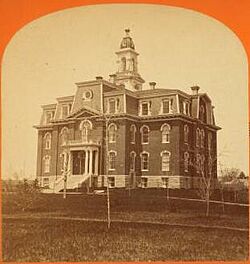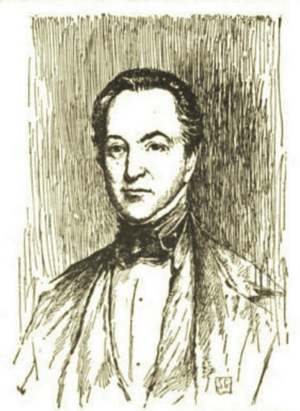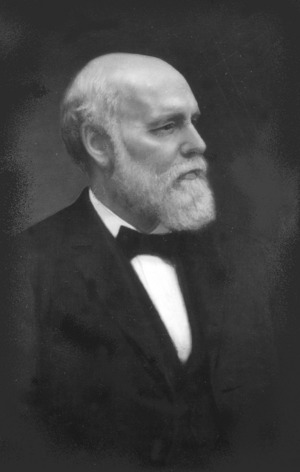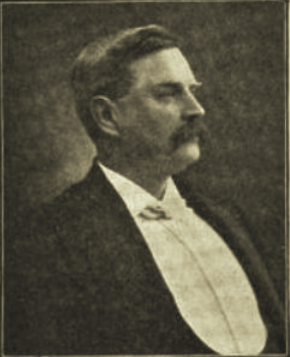Robinson Female Seminary facts for kids
Quick facts for kids Robinson Female Seminary |
|
|---|---|

(ca. 1870–80)
|
|
| Location | |
|
Exeter, New Hampshire, U.S.
|
|
| Information | |
| Type | day and boarding school |
| Established | 1867 |
| Founder | William Robinson |
| Closed | 1955 |
| School board | Board of trustees |
| Principal |
|
| Gender | girls |
| Age range | Nine and older |
| Campus size | 16 acres (6.5 ha) |
The Robinson Female Seminary was a special school for girls in Exeter, New Hampshire. It was a day school, meaning students went home after classes, and also a boarding school, where some students lived there.
A kind man named William Robinson started the school. He grew up in Exeter and wanted to help the town. In his will, he left a lot of his money to Exeter to create a school just for girls.
The town of Exeter accepted his generous gift. They created rules for how the school would be run. More than US$250,000 was used to set up the school.
In 1867, the school opened its doors to students. By 1869, it was fully ready in its new building. Robinson Seminary was one of the first schools in the U.S. to teach "domestic science," which is about home skills. The school closed in 1955.
Contents
The Story of Robinson Seminary
The Robinson Seminary was created thanks to a large gift from William Robinson. He was from Exeter but lived in Augusta, Georgia for many years. He passed away during the Civil War.
Mr. Robinson wanted the school to teach girls practical skills. He hoped they would be able to succeed in life, just like their brothers. He also wanted poor and orphaned girls to be given a special chance to attend.
The town of Exeter received about US$250,000 from his will. They put this money into a fund managed by trustees. The town made tuition free for all girls from Exeter who were at least nine years old and ready for grammar school. They also provided books and school supplies.
The school first opened in 1867 in the old town hall. A large piece of land, about 16 acres (6.5 ha), was bought for the new building. On July 4, 1868, the first stone of the seminary building was laid. The building was finished in 1869, and the school officially started there in September of that year.
How the School Was Run
The town chose a group of trustees to manage the school and its money.
Eben S. Stearns was the first principal of the seminary. He started in 1867 and stayed until 1875. During his time, the school became well-organized and successful. Just three years after it opened, there were nine teachers and 252 students.
After Mr. Stearns, Harriet E. Paine and Annie M. Kilham led the school. In 1883, George N. Cross became the new principal.
When Mr. Cross arrived in 1883, the school was facing challenges. Its funds were low, and it wasn't very well known. Mr. Cross worked hard to create new rules and a useful course of study.
In just a few years, Robinson Seminary became famous across New England. It was known for having one of the most beautiful school buildings. Mr. Cross filled the schoolrooms with beautiful pictures and the hallways with sculptures. These art pieces weren't just for decoration. They helped students learn about history, myths, and literature.
After 23 years, Mr. Cross retired. Most students at the seminary lived in Exeter. However, students from other towns could attend for a small fee.
The School Building and Its Features
The school building was designed by architect Rufus Sargent. It was made of brick with a strong granite base and had three stories.
Inside, the school had a large library with over 6,000 books. It also had special equipment for science classes, like microscopes. There were collections of minerals and rocks, and charts for studying plants. A chemistry lab was set up for experiments.
Robinson Seminary also had a wonderful art collection. It included many rare pictures, etchings, busts, and statues. Mr. Cross started this collection with money raised from school events. Later, people gave generous gifts to expand it.
What Students Learned
The main course of study at Robinson Seminary lasted eight years. There was also a three-year course to prepare students for college. Girls could get a very good education here, similar to other top schools in the U.S.
Most students didn't complete the full eight-year course. But many stayed long enough to get a strong education.
Mr. Cross had three main goals for the girls' education:
- To teach them about homemaking and the importance of home life.
- To help them become independent.
- To prepare them to earn a living if they chose to.
- To get them ready for college if they wanted to go.
Robinson Seminary was one of the first schools in the U.S. to teach "domestic science." This course taught skills like cooking. The school's kitchen was a model for many other schools. Cooking lessons were taught by a graduate of the Boston Cooking School.
For many years, the school also offered a special course for graduates who wanted to become teachers. Many teachers in New England learned their first teaching methods at Robinson Seminary.
The School's Closing
Robinson Seminary was the public high school for girls in Exeter until 1955. Boys in town went to Tuck High School. In 1954, the town decided to build an addition to Tuck School. This created Exeter High School, which started teaching both boys and girls together in 1956.
The Robinson Seminary building was sadly destroyed by a fire in 1961. Today, the Lincoln Street Elementary School stands on the same site.
Notable People from Robinson Seminary
Alumni
- Alice Brown (writer) (1857–1948), a writer of novels, poems, and plays.
- Dudley Dudley (politician) (born 1936), a political activist.
- Mary Lemist Titcomb (1852–1932), a famous librarian.
Faculty
- Anna Barrows (1861–1948), an educator and author.
- Mary Stuart James MacMurphy (1846–1934), a teacher, lecturer, and author.






